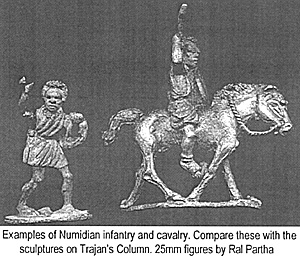 Numidian kings were never able to come up with decent infantry, although they did succeed in some improvement under King Syphax. During the Second Punic War he was able to obtain the services of a Roman centurion Quintus Statorius. Livy has Syphax saying his army was quite shapeless and haphazard, a mere casual mob. The centurion went to work.
Numidian kings were never able to come up with decent infantry, although they did succeed in some improvement under King Syphax. During the Second Punic War he was able to obtain the services of a Roman centurion Quintus Statorius. Livy has Syphax saying his army was quite shapeless and haphazard, a mere casual mob. The centurion went to work.
Examples of Numidian infantry and cavalry. Compare these with the sculptures on Trajan's Column. 25mm figures by Ral Partha>
"Statorius found ample material from which to enroll infantry soldiers for Syphax; he organized them very much after the Roman pattern, gave them instruction in forming up, maneuvering, following the standards, and keeping formation, and accustomed them to various military duties, including fortifications, and all so successfully that the prince soon came to trust his infantry no less than his cavalry, and that when an engagement took place on open ground he defeated his Carthaginian foe." [Livy, The History of Rome Book XXIV]
This was obviously too dangerous for Carthage who allied with the most famous Numidianprince Masinissa to annihilate Syphaxs army. Some vestige of the training of Statorius must have stuck, because the Numidian infantry is never referred to as a formless mass in later times. In fact, the formations do seem to echo the Roman maniples and although this can only be conjecture, the infantry fight in a mix of Roman and Numidian techniques as a sort of light infantry. Showing an ability to maintain unit cohesion and rally to standards like the Roman troops, while attempting to avoid direct contact in their native fashion.
"When Jugurtha saw that Metellus' rearguard had passed the first lines of his own army, he stationed a force of some two thousand infantry on the hill at the point where Metellus had descended, so that the Romans would not be able to retreat to it and defend themselves there. Immediately afterwards he gave the order to attack. The rear of Metellus' column suffered heavy casualties and both flanks were assailed by mobile assailants who pressed home their attacks and spread general confusion in the Roman ranks. For even the men who resisted with the most dogged courage were disconcerted by this irregular manner of fighting, in which they were wounded at long range without being able to strike back or come to grips with their foe [Sallust, The Jugurthine War. 5 1 ]
When the infantry had to wait for combat closer formations were favoured, because troops in close formations are less likely to run away. These would be extended to deliver an attack. This is more suggestive of light infantry troops. It should be noted that the Numidians also made good skirmish troops. This type of fighting entirely suiting their nature. "Accordingly, he altered the formation of his battle line, which, because he distrusted his men's courage, he had drawn up in close order. He now extended it so he would be able to block the enemies line of march." [Sallust, The Jugurthine War. 53]
More Numidians
-
The People
Numidians at War
Numidian Cavalry
Numidian Infantry
Numidian Elephants
Wargaming with a Numidian Army
Back to Strategikon Vol. 1 No. 2 Table of Contents
Back to Strategikon List of Issues
Back to MagWeb Master Magazine List
© Copyright 2001 by NMPI
This article appears in MagWeb (Magazine Web) on the Internet World Wide Web. Other military history articles and gaming articles are available at http://www.magweb.com